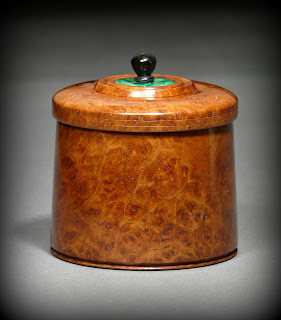A lot of my woodturning time lately has been spent turning lidded "keepsake" (or jewelry) boxes. I like to call them "treasure boxes" too, since they're so often used to protect those special little treasures we accumulate.
As is true with most of my turning, I like to experiment with as many different species of wood as I can, since I get as much enjoyment from that aspect of the work as I do from the turning itself.
This first jewelry box is made from Apple wood. It features a shallow lift-out tray for the "smalls", and deeper space beneath it. The lid is capped with a handmade pull that's (what else?) a miniature apple.
 |
| Apple Jewelry Box w/ Lift-Out Tray |
Woodturners who make lidded boxes often take great pride in their ability to make the lid so carefully that it goes onto the box very snugly, and, when it's removed, it creates a little vacuum that makes a slight "pop". That's a testament to their skills, but it's also a frustration to someone using the box, since it requires two hands to take the lid off.
 |
| Lift-out tray on right |
 |
| Claro Walnut Burl (Desert Ironwood Pull) |
 |
| Pistachio Wood Box |
Staying with the "nut tree" theme, the next example is a treasure box fashioned from Pistachio wood. This wood's variegated tones and swirly grain lines make it one of my favorites. It's a hard, yet fairly easily worked material, and results in a very pleasing product. While debating what the lid's pull should be, I decided to carve a pistachio nut, so that's what graces the lid.
There are some burl woods on this planet that are highly valued, and constantly sought after. One such wood is Amboyna burl. It commands a respectable price, and is simply beautiful. It may be familiar to you if you've ever had the opportunity to peer into a classic luxury automobile that was fitted with a wooden dashboard (I'm assuming you haven't actually owned such a vehicle!).
 |
| Amboyna Burl Box |
 |
| Malachite Inlay |
The cover atop this keepsake box is highlighted with a malachite stone inlay, and has a genuine Ebony pull.
An eclectic mix of wood species was brought together to form the next piece, a turned and carved treasure box. Appreciating trees as I do, I wanted to carve tree silhouettes into this box. That was accomplished by turning a thin tube of Slippery Elm, then piercing it to form the silhouettes. A liner of lighter colored Gingko was turned and inserted into the Elm tube. Finally, the lid was turned from Slippery Elm, and fitted with a pull of Black Palm.

 |
| Slippery Elm, Gingko, Black Palm |
From Australia comes a wood that's rarely obtainable in America, known as Mulga. The contrast between its deep, rich, reddish-brown heartwood and its creamy sapwood is an eye-catching treat. The wood is hard, dense, and heavy. For this jewelry box, a lift-out tray of Apple was turned, and the pull is of the same Apple.
 |
| Australian Mulga Jewelry Box |
 |
| Mulga w/ Apple Tray |
Another rare Australian beauty (there are so many!) is Jarrah Burl. Look at its depth of color and its figure in this next keepsake box. To further enhance it, the natural cracks and voids in the wood were filled with turquoise inlay; the pull was turned from a turquoise-colored piece of specially treated and dyed Boxelder Burl.
 |
| Jarrah Burl |
 |
| Turquoise Inlay |
These and many other boxes are available in the "Boxes" gallery at Bowlwood.

No comments:
Post a Comment
Comments are moderated and may not be posted immediately.